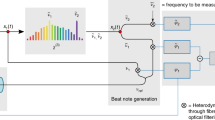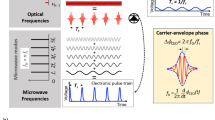Abstract
Measurements using optical frequency combs1,2,3,4,5,6 are now important in high-precision spectroscopy. However, measurement techniques described so far are either restricted to narrow frequency ranges or are difficult to implement in the far-infrared regime. Here we present a time-domain method for the direct measurement of optical frequencies in the mid- and far-infrared spectral region. The method is analogous to a sampling scope, with the electric field of the source measured by electro–optic sampling7,8,9,10,11,12,13 using the light pulses from a femtosecond laser as a probe. The highest optical frequency that can be measured with our ‘sampling scope’ is determined by the pulse length of the femtosecond laser. When 12-fs probe pulses are used, a measurement of up to 40 THz, corresponding to a wavelength of 7.5 µm, is possible9.
This is a preview of subscription content, access via your institution
Access options
Subscribe to this journal
Receive 12 print issues and online access
$209.00 per year
only $17.42 per issue
Buy this article
- Purchase on Springer Link
- Instant access to full article PDF
Prices may be subject to local taxes which are calculated during checkout




Similar content being viewed by others
References
Udem, T., Reichert, J., Holzwarth, R. & Hänsch, T. W. Absolute optical frequency measurement of the cesium D1 line with a mode-locked laser. Phys. Rev. Lett. 82, 3568–3571 (1999).
Hall, J. L. et al. Ultrasensitive spectroscopy, the ultrastable lasers, the ultrafast lasers, and the seriously nonlinear fiber: A new alliance for physics and metrology. IEEE J. Quantum Electron. 37, 1482–1492 (2001).
Holzwarth, R., Zimmermann, M., Udem, T. & Hänsch, T. W. Optical clockworks and the measurement of laser frequencies with a mode-locked frequency comb. IEEE J. Quantum Electron. 37, 1493–1501 (2001).
Amy-Klein, A. et al. Absolute frequency measurement in the 28-THz spectral region with a femtosecond laser comb and a long-distance optical link to a primary standard. Appl. Phys. B 78, 25–30 (2004).
Siemsen, K. J. & Bernard, J. E. A phase-sensitive technique to measure small changes in laser frequency: Application to measure the shift and broadening of a saturated absorption line of OsO4 . Appl. Phys. B 81, 497–502 (2005).
Amy-Klein, A. et al. Absolute frequency measurement of a SF6 two-photon line by use of a femtosecond optical comb and sum-frequency generation. Opt. Lett. 30, 3320–3322 (2005).
Wu, Q. & Zhang, X.-C. Free-space electro-optic sampling of terahertz beams. Appl. Phys. Lett. 67, 3523–3525 (1995).
Wu, Q. & Zhang, X.-C. Free-space electro-optics sampling of mid-infrared pulses. Appl. Phys. Lett. 71, 1285–1286 (1997).
Huber, R., Brodschelm, A., Tauser, F. & Leitenstorfer, A. Generation and field-resolved detection of femtosecond electromagnetic pulses tunable up to 41 THz. Appl. Phys. Lett. 76, 3191–3193 (2000).
Leitenstorfer, A., Hunsche, S., Shah, J., Nuss, M. C. & Knox, W. H. Detectors and sources for ultrabroadband electro-optic sampling: Experiment and theory. Appl. Phys. Lett. 74, 1516–1518 (1999).
Reimann, K., Smith, R. P., Weiner, A. M., Elsaesser, T. & Woerner, M. Direct field-resolved detection of terahertz transients with amplitudes of megavolts per centimeter. Opt. Lett. 28, 471–473 (2003).
Kübler, C., Huber, R., Tübel, S. & Leitenstorfer, A. Ultrabroadband detection of multi-terahertz field transients with GaSe electro-optic sensors: Approaching the near infrared. Appl. Phys. Lett. 85, 3360–3362 (2004).
Bartel, T., Gaal, P., Reimann, K., Woerner, M. & Elsaesser, T. Generation of single-cycle THz transients with high electric-field amplitudes. Opt. Lett. 30, 2805–2807 (2005).
Kaindl, R. A. et al. Homogeneous broadening and excitation-induced dephasing of intersubband transitions in a quasi-two-dimensional electron gas. Phys. Rev. B 63, 161308(R) (2001).
Press, W. H., Flannery, B. P., Teukolsky, S. A. & Vetterling, W. T. Numerical Recipes (Cambridge Univ. Press, Cambridge, 1986).
Frigo, M. & Johnson, S. G. The design and implementation of FFTW3. Proc. IEEE 93, 216–231 (2005).
Ramond, T. M., Diddams, S. A., Hollberg, L. & Bartels, A. Phase-coherent link from optical to microwave frequencies by means of the broadband continuum from a 1-GHz Ti:sapphire femtosecond oscillator. Opt. Lett. 27, 1842–1844 (2002).
Bartels, A. & Kurz, H. Generation of a broadband continuum by a Ti:sapphire femtosecond oscillator with a 1-GHz repetition rate. Opt. Lett. 27, 1839–1841 (2002).
Planken, P. C. M., Nienhuys, H.-K., Bakker, H. J. & Wenckebach, T. Measurement and calculation of the orientation dependence of terahertz pulse detection in ZnTe. J. Opt. Soc. Am. B 18, 313–317 (2001).
Leitenstorfer, A., Fürst, C. & Laubereau, A. Widely tunable two-color mode-locked Ti:sapphire laser with pulse jitter of less than 2 fs. Opt. Lett. 20, 916–918 (1995).
Waller, I. Zur Frage der Einwirkung der Wärmebewegung auf die Interferenz von Röntgenstrahlen. Z. Phys. 17, 398–408 (1923).
Acknowledgements
The authors acknowledge financial support by the Deutsche Forschungsgemeinschaft.
Author information
Authors and Affiliations
Corresponding author
Rights and permissions
About this article
Cite this article
Gaal, P., Raschke, M., Reimann, K. et al. Measuring optical frequencies in the 0–40 THz range with non-synchronized electro–optic sampling. Nature Photon 1, 577–580 (2007). https://doi.org/10.1038/nphoton.2007.170
Received:
Revised:
Accepted:
Published:
Issue Date:
DOI: https://doi.org/10.1038/nphoton.2007.170
This article is cited by
-
Terahertz Frequency Combs
Journal of Infrared, Millimeter, and Terahertz Waves (2014)
-
Phase seeding of a terahertz quantum cascade laser
Nature Communications (2010)
-
Sampling without synchronization
Nature Photonics (2007)



